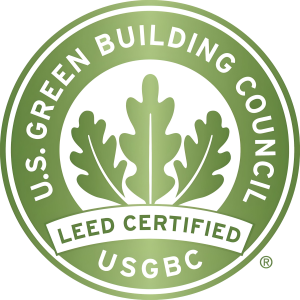As we prepare for the release of LEED v5 in 2025, take a closer look at how the current draft addresses Ecological Conservation and Restoration. As one of the three impact areas driving the rating system update, 25% of the rating system points directly or indirectly address this important focus. Decarbonization is addressed by 50% of the points, and Quality of Life is addressed by the remaining 25%.
Why ecological conservation and restoration matters
The Intergovernmental Panel on Climate Change (IPCC) and other scientific bodies have underscored the critical need to protect and restore at least 30% of the world’s land and seas by 2030 in order to mitigate the worst effects of climate change. This “30 by 30 goal” was formally adopted as part of the Convention on Biological Diversity’s Kunming-Montreal Global Biodiversity Framework. It represents a bold and urgent global effort to mitigate the worst impacts of climate change, halt biodiversity loss and enhance ecosystem resilience, with a relatively short opportunity to do so.
Additionally, research continues to correlate biodiversity and access to local green space with both mental and physical human health and well-being. Thus, this goal impacts not only the health of the planet, but the communities and individuals that inhabit it. While the “30 by 30” goal requires action across multiple sectors and ecosystems, LEED projects are well positioned to contribute meaningfully to this global initiative.
How LEED v5 addresses ecosystem protection
The ecological conservation and restoration impact area of LEED v5 emphasizes strategies and actions that can be implemented at the individual asset level that limit environmental degradation and seek to rehabilitate and restore ecosystems.
LEED’s comprehensive framework considers the interconnectedness of ecological systems and human-built environments, aiming to minimize ecological harm while promoting restoration and biodiversity conservation. They have been developed through thousands of volunteer hours and in collaboration with the LEED committees, along with two rounds of public comment.
This impact area is encouraged through three main strategies:
- Conserving natural habitats
- Restoring natural habitats
- Efficiently using resources that impact natural habitats
These strategies have been designed to be both project-specific (benefiting the project’s ecosystems directly) and impactful on a larger scale (such as reducing downstream impacts from supply chain purchases). They build upon previous iterations of LEED, and are designed to be more accessible for projects of varying density and location.
Let’s delve further into what this means at the credit level.
Conserving natural habitats
LEED v5 encourages practices that minimize the negative impacts of construction activities and reward deliberate consideration of local species and ecosystems throughout site design, development and management. To limit urban sprawl and protect sensitive ecosystems, LEED v5 encourages development on infill sites and areas with existing infrastructure, minimizing the environmental impact of where and how we build.
Key strategies include:
- Protecting sensitive lands
- Minimizing impacts to land and wildlife
- Increasing density and mobility options
This includes credits such as:
- Building Design and Construction (BD+C) prerequisite Minimize Site Disturbance. Limit site disturbance from construction activities and preserve existing native vegetation, healthy soils and wildlife habitats.
- BD+C credit Sensitive Land Protection. Cultivate community resilience by avoiding the development of environmentally sensitive lands that provide critical ecosystem services and reduce the environmental impact from the location of a building on a site.
- BD+C credit Compact and Connected Development. Conserve land and ecosystem resources by encouraging development in areas with existing infrastructure. Promote livability, walkability and transportation efficiency, including reduced vehicle distance traveled and associated emissions.
- Operations and Maintenance (O+M) credit Sustainable Transportation Performance. Evaluate the performance of active and shared modes of transportation.
- O+M credit Light Pollution and Bird Collision Reduction. Increase night sky access, improve nighttime visibility, and reduce the consequences of development for wildlife and people.
Restoring natural habitats
To encourage projects to aim beyond merely reducing impact, LEED v5 supports biodiversity through thoughtful development that rehabilitates damaged ecosystems. To boost the health of these vital systems, LEED encourages projects to consider how to actively benefit the systems around them and boost green space that allows pollinators and wildlife to flourish.
Key strategies include:
- Restoring natural habitat
- Supporting natural water cycles
- Creating resilient sites



